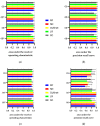Optimized Identification of Advanced Chronic Kidney Disease and Absence of Kidney Disease by Combining Different Electronic Health Data Resources and by Applying Machine Learning Strategies
- PMID: 32932685
- PMCID: PMC7563476
- DOI: 10.3390/jcm9092955
Optimized Identification of Advanced Chronic Kidney Disease and Absence of Kidney Disease by Combining Different Electronic Health Data Resources and by Applying Machine Learning Strategies
Abstract
Automated identification of advanced chronic kidney disease (CKD ≥ III) and of no known kidney disease (NKD) can support both clinicians and researchers. We hypothesized that identification of CKD and NKD can be improved, by combining information from different electronic health record (EHR) resources, comprising laboratory values, discharge summaries and ICD-10 billing codes, compared to using each component alone. We included EHRs from 785 elderly multimorbid patients, hospitalized between 2010 and 2015, that were divided into a training and a test (n = 156) dataset. We used both the area under the receiver operating characteristic (AUROC) and under the precision-recall curve (AUCPR) with a 95% confidence interval for evaluation of different classification models. In the test dataset, the combination of EHR components as a simple classifier identified CKD ≥ III (AUROC 0.96[0.93-0.98]) and NKD (AUROC 0.94[0.91-0.97]) better than laboratory values (AUROC CKD 0.85[0.79-0.90], NKD 0.91[0.87-0.94]), discharge summaries (AUROC CKD 0.87[0.82-0.92], NKD 0.84[0.79-0.89]) or ICD-10 billing codes (AUROC CKD 0.85[0.80-0.91], NKD 0.77[0.72-0.83]) alone. Logistic regression and machine learning models improved recognition of CKD ≥ III compared to the simple classifier if only laboratory values were used (AUROC 0.96[0.92-0.99] vs. 0.86[0.81-0.91], p < 0.05) and improved recognition of NKD if information from previous hospital stays was used (AUROC 0.99[0.98-1.00] vs. 0.95[0.92-0.97]], p < 0.05). Depending on the availability of data, correct automated identification of CKD ≥ III and NKD from EHRs can be improved by generating classification models based on the combination of different EHR components.
Keywords: ICD-10 billing codes; area under the precision-recall curve (AUCPR); area under the receiver operating characteristic (AUROC); artificial neural network (ANN), clinical natural language processing (clinical NLP); chronic kidney disease (CKD); discharge summaries; electronic health record (EHR); estimated glomerular filtration rate (eGFR); generalized linear model network (GLMnet); laboratory values; machine learning (ML); no known kidney disease (NKD); phenotyping; random forest (RF).
Conflict of interest statement
The authors declare no conflict of interest.
Figures





Similar articles
-
Prediction of acute and chronic kidney diseases during the post-covid-19 pandemic with machine learning models: utilizing national electronic health records in the US.EBioMedicine. 2025 May;115:105726. doi: 10.1016/j.ebiom.2025.105726. Epub 2025 Apr 26. EBioMedicine. 2025. PMID: 40288236 Free PMC article.
-
Identification of Patients With Congestive Heart Failure From the Electronic Health Records of Two Hospitals: Retrospective Study.JMIR Med Inform. 2025 Apr 10;13:e64113. doi: 10.2196/64113. JMIR Med Inform. 2025. PMID: 40208662 Free PMC article.
-
Developing a FHIR-based EHR phenotyping framework: A case study for identification of patients with obesity and multiple comorbidities from discharge summaries.J Biomed Inform. 2019 Nov;99:103310. doi: 10.1016/j.jbi.2019.103310. Epub 2019 Oct 14. J Biomed Inform. 2019. PMID: 31622801 Free PMC article.
-
Predicting the Progression of Chronic Kidney Disease: A Systematic Review of Artificial Intelligence and Machine Learning Approaches.Cureus. 2024 May 12;16(5):e60145. doi: 10.7759/cureus.60145. eCollection 2024 May. Cureus. 2024. PMID: 38864072 Free PMC article. Review.
-
Selecting the right therapeutic target for kidney disease.Front Pharmacol. 2022 Nov 2;13:971065. doi: 10.3389/fphar.2022.971065. eCollection 2022. Front Pharmacol. 2022. PMID: 36408217 Free PMC article. Review.
Cited by
-
Predict, diagnose, and treat chronic kidney disease with machine learning: a systematic literature review.J Nephrol. 2023 May;36(4):1101-1117. doi: 10.1007/s40620-023-01573-4. Epub 2023 Feb 14. J Nephrol. 2023. PMID: 36786976 Free PMC article.
-
Prediction of 3-year risk of diabetic kidney disease using machine learning based on electronic medical records.J Transl Med. 2022 Mar 26;20(1):143. doi: 10.1186/s12967-022-03339-1. J Transl Med. 2022. PMID: 35346252 Free PMC article.
-
Invasive Versus Medical Management in Patients With Chronic Kidney Disease and Non-ST-Segment-Elevation Myocardial Infarction.J Am Heart Assoc. 2022 Jun 17;11(12):e025205. doi: 10.1161/JAHA.121.025205. Online ahead of print. J Am Heart Assoc. 2022. PMID: 35713283 Free PMC article.
-
Machine-learning-based identification of patients with IgA nephropathy using a computerized medical billing database.PLoS One. 2024 Dec 5;19(12):e0312915. doi: 10.1371/journal.pone.0312915. eCollection 2024. PLoS One. 2024. PMID: 39637040 Free PMC article.
-
Prediction of early clinical response in patients receiving tofacitinib in the OCTAVE Induction 1 and 2 studies.Therap Adv Gastroenterol. 2021 Nov 29;14:17562848211054710. doi: 10.1177/17562848211054710. eCollection 2021. Therap Adv Gastroenterol. 2021. PMID: 35154388 Free PMC article.
References
-
- Xie Y., Bowe B., Mokdad A.H., Xian H., Yan Y., Li T., Maddukuri G., Tsai C.Y., Floyd T., Al-Aly Z. Analysis of the Global Burden of Disease study highlights the global, regional, and national trends of chronic kidney disease epidemiology from 1990 to 2016. Kidney Int. 2018;94:567–581. doi: 10.1016/j.kint.2018.04.011. - DOI - PubMed
-
- Kidney Disease: Improving Global Outcomes (KDIGO) CKD Work Group KDIGO 2012 Clinical Practice Guideline for the Evaluation and Management of Chronic Kidney Disease. Kidney Int. Suppl. 2013;3:1–150.
Grants and funding
LinkOut - more resources
Full Text Sources
Research Materials
Miscellaneous

